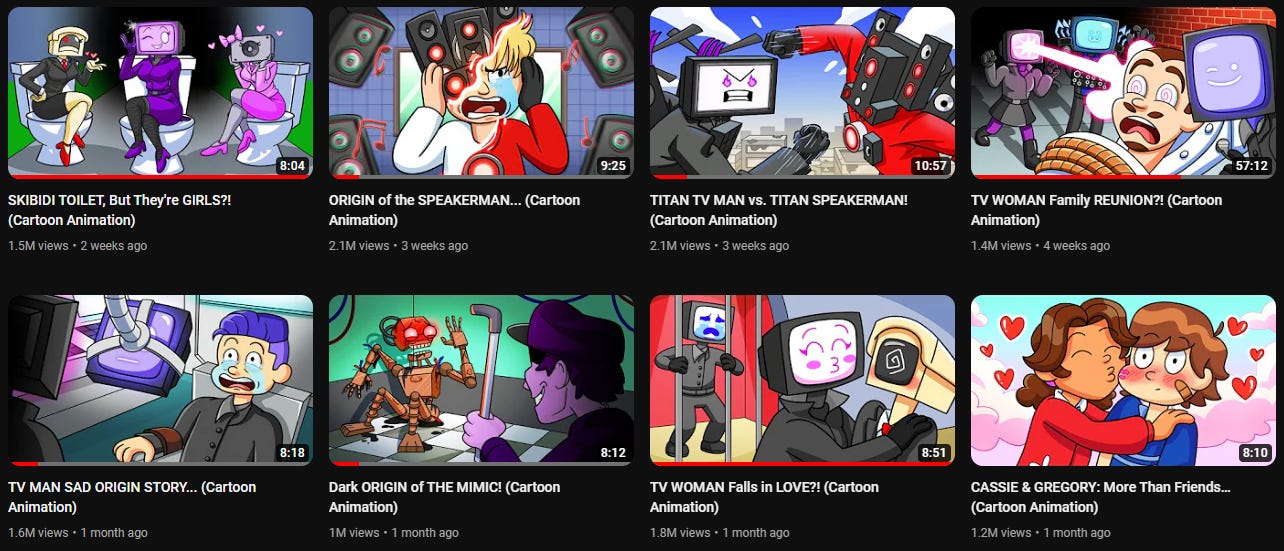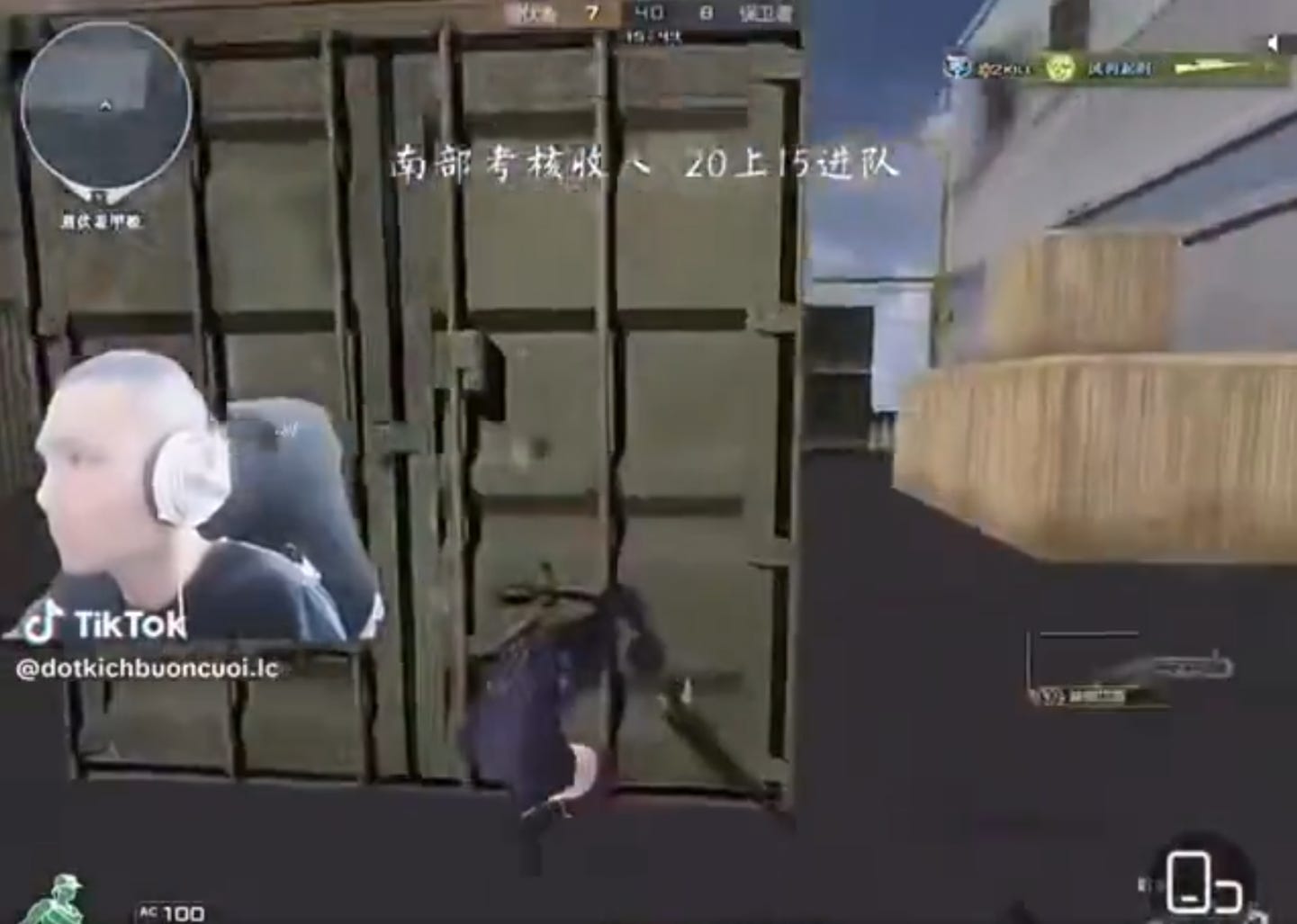Slides beyond comprehension
Also: a return to form, a return to rock, and the return of Cait Sith.
EX is a research report about where culture is headed. You can learn more here. This week: how old is Sephiroth, anyway?
1. Cocoon has got that Playdead sauce
If you haven’t played Limbo or Inside, Playdead’s pair of cinematic platformers from 2010 and 2016, respectively, you can rectify it easily. Both are short, playable on pretty much any platform imaginable, and are often discounted or free or bundled with other services. They’re also two absolute titans of the form — macabre, witty, and ingeniously designed, their puzzle concepts elegantly dispersed throughout story-rich, fog-enshrouded environs, each mechanical revelation unlocking new waves of ambient sound design. It felt only too fitting that the small team, founded in part by Danish arts grants, started splintering into new side projects shortly after Inside’s release. Playdead seemed too good to last.
Somerville, released earlier this year, was the anointed successor, the first game from a new studio founded by Playdead’s former CEO Dino Patti. But it came and went with little more than a breathless Edge magazine cover story, its much-touted light-and-physics puzzles resolving with little complication. In a twist, it’s the heretofore slept-on Cocoon — out this week, and developed in part by former Playdead designer Jeppe Carlsen and composer Jakob Schmid — that has the old Playdead mojo intact, jettisoning the horror environs of that studio’s games for an austere sci-fi exploration story.
Ignore its post-Hyper Light indie-game art style; five minutes with controller in hand, puzzles swirling through your brain and cosmic chimes echoing through your headphones, and you will know that one of the greatest lineages in games has found an unlikely successor. It’s so good it almost retroactively redeems Somerville; you can see a single creative idea splintering in two, one toward something grounded, narrative, and ultimately unfulfilling, and the other toward something cosmic, mechanical, and altogether new. (Playdead’s remaining staff, meanwhile, remain at work on a third sci-fi game, as-yet unseen by the world.)
2. Skibidi toilet is big business
The Skibidi toilet mind virus that has infected nearly all iPad kids is still going strong. Its creator, @DaFuqBoom (or DFB), now has more than 31M subs and 12B views on his long-running “evil toilets vs. electronics-heads” series. And this rising tide has lifted a lot of other singing toilet-filled boats. There are channels with hundreds of thousands of subs that just do Skibidi toilet analysis. Unofficial Skibidi content — “multiverse” videos or random animated cameraman/speakerwoman sludge — is huge among the types of channels that usually deal in mascot horror playground tales and Minecraft skits.
Lately, DFB has started sending takedown requests to imitators. The channel Gametoons was able to work it out with him; other channels, which DFB deemed offensive “Elsagate types of content farm & NSFW” on his Discord, could not. A more significant controversy broke out this week when Roblox channels learned that DFB had taken action against a popular Skibidi toilet knockoff game (Toilet Tower Defense) and its creator Telanthric in late September. The legal questions are more interesting than the drama: given that skibidi toilet was made with assets from Valve games and pre-existing music, would DFB’s copyright claims really hold up? Nobody seems eager to find out.
3. DALL-E 3 is coming for Roblox
The latest version of OpenAI’s text-to-image software DALL-E 3 is now free to use in the form of the Bing Image Creator, and people everywhere are finally urging each other to “Bing it!” To a regular user, DALL-E 3 seems better at generating images that are bizarre in the way you meant them to be, rather than distorted by Midjourney’s weird takes on your prompt. But you still see mangled hands and blank eyes everywhere. As Sridhar Ramesh said, it feels like we’re re-running a previous cycle of AI joke posting with a new +1 version of the tech, but the novelty will soon wear off again for comedy types.
However, DALL-E 3 has immediately alarmed one group of people: the artists who make “GFX” icons for Roblox games using Blender. The AI model seems very good at cartoons and naturally adept at creating scenes in the blocky, fingerless world of Robloxians. There’s been a lot of concern among the community, but it’s not clear yet how many paying jobs will really be replaced by someone Binging up batches of icons. (Incidentally, sexed-up YouTube thumbnails, like the ones used by T&A RPG channel @MxRMods, seem like another common use case for AI image tech, but it’s unclear if the heavily content-filtered Bing AI will give them much to work with.)
4. This bargain-bin CS:GO is one of the world’s most-played games
This clip's great: A streamer fails to defeat a player donning a clown mask in what appears to be a "headshots only" mode (which would explain the erratic quick-scoping). If the gritty backdrop and lo-fi assets remind you of a knock-off Counter-Strike, then you're not far off — this is CrossFire, an FPS that's been one of the world's most-played games for years.
Tuning into non-English-speaking streams can at times feel like glimpsing an alternate reality. What at first looks like a smdgy Fortnite is actually, upon further inspection, Garena: Free Fire; the only thing familiar about Dungeon Fighter Online is that it looks kind of Diablo II if it were a Golden Axe-type beat-'em-up. Though Crossfire came out in 2007, it continues to be especially popular in China. Current metrics are difficult to identify with certainty, but SmileGate, the game's South Korean developer, claims that the game reached one billion registered users in 2020.
5. New milestones in the quest to beat Mario without pressing the A button
If you’ve fallen into an internet rabbit hole involving Super Mario 64 at any point in the last seven years, you’ve probably seen the work of pannenkoek2012. The channel, which specializes in obscure SM64 glitches and a quixotic dedication to beating the game without pressing the A button, became a minor sensation in 2016 with the release of “Watch for Falling Rocks - 0.5x A Presses.” The counter-intuitive concepts explained in the video, like “half A presses” and “parallel universes,” became emblematic of the arcane tricks developed by the SM64 community and a byword for mind-boggling speedrun tactics in general. The channel is also very good at visual explanations of coding stuff like floating-point precision glitches that occur in many games; that video has been used online to explain everything from an old Skyrim glitch to precision-loss bugs in Minecraft.
This week, pannenkoek updated his no-commentary channel with a true zero A-press run of “Watch for Falling Rocks” made possible by a newly discovered glitch. Many YouTube speedrunners reminisced in the comments about the impact of the original video: “I remember the release of the original 0.5xA strat like it was yesterday,” wrote Bismuth9. The quest to collect all 120 stars without pressing A has marched on as well, falling from 211 A-presses in 2013 (back when pannenkoek got started) to just 13 this year.
6. FFVII’s lore keeps getting dizzier
The one thing you can count on with Tetsuya Nomura is that he will never leave his own stories alone. He can't resist the opportunity to explode his narrative worlds into webs of timelines and subplots that span several titles and dozens of characters. It happened with Kingdom Hearts, it happened with The World Ends With You, and now it's happening with Final Fantasy VII.
The current state of the Final Fantasy VII remake project has Nomura written all over it. 2020's Remake, which Nomura directed, already diverged from the 1997 original's plot in significant ways, confirming to fans that the very term "Remake" — in true Nomura fashion — has layered meanings. As Square Enix teases details about next year's Rebirth, they risk sending devoted lorehounds into a frenzy. Some contest Rebirth's "official" pronunciation of "Cait Sith" while others question the continuity behind Sephiroth's age. Still others speculate tirelessly over side characters who appear in trailers, gleaning clues from officially licensed light novels that expand the game's universe. Reimagining a story as beloved as FFVII's is a delicate process — yet, at the same time, it isn't that surprising that Nomura would want to get his hands dirty and wrench the narrative in a bunch of bizarre directions. It's what he does best.
7. Analogue’s got the “sneakerheads of gaming” in their pocket
Analogue are an anomaly in the world of gaming hardware in more ways than one. On paper, their products — boutique consoles with chips capable of highly accurate emulation — sound like they'd only really appeal to a niche audience. Yet, somehow, discontinued Analogue products sell for as much as five times the original price, like this $2,500 NT Mini on eBay. Meanwhile, limited "glow in the dark" editions of the Analogue Pocket that were recently released at a $250 price point sell for twice as much. Seeing scalping and price gouging on par with sneaker culture is relatively rare for companies of Analogue's scope, a third-party hardware manufacturer who specializes mostly in games made over 25 years ago.
There are a couple of sensible reasons for the hype. In addition to sophisticated hardware emulation and modern conveniences like HDMI support, one of the "hidden" value propositions of Analogue's products is that they're usually jailbroken by an anonymous developer named "Spiritualized1997" — widely speculated to be one of Analogue's own design leads — shortly after release. This essentially allows users to play pirated ROMs off of an SD card, a much cheaper alternative to poaching original cartridges for vintage consoles.
Since its release, community developers have turned the Analogue Pocket into a convenient and highly capable device for emulating everything from the Game Boy and Game Gear to obscure consoles like the WonderSwan, the Mega Duck, and the Watara Supervision. It's ironically become an accessible way for players to sample rare or overlooked games that might otherwise slip into the annals of time, though that's more accurate if you can land a Pocket for its original price.
Chum Box
LCD Soundsystem has reunited yet again, this time in an exclusive engagement for American Express cardholders. They previously reunited for a half-empty Bored Ape Yacht Club event. Anti-millennial sentiment seems to have calcified enough that people are beginning to declare the emperor has no jams, perhaps in direct response to the tenor of the internet during LCDSS’ peak.
This thread intended to show off the image-analysis capabilities of ChatGPT 4 is really just a showcase for hyper-complex, deep-state Pentagon slideware.
Peter Molyneux’s blockchain-based game Legacy announced a release date of October 26, inspiring a raft of pithy headlines. But its $54 million presale of NFT land deeds is big enough that it’s all at least worth taking seriously as a case study.
Johnny Silverhands has returned to rock.
“Xelon Musk” is the latest sinister comedy video from cult animator Aamon, who incorporates real audio and gaming curiosities like Dark Souls’ Egg Carriers into his sketches.
A Japanese magazine called Monthly Halloween “routinely featured the best covers ever.” (via @orringrey)
It’s never too late to learn how to play Street Fighter from a 1993 instructional tape.
That’s it for this week. Enjoy monthly Halloween.






